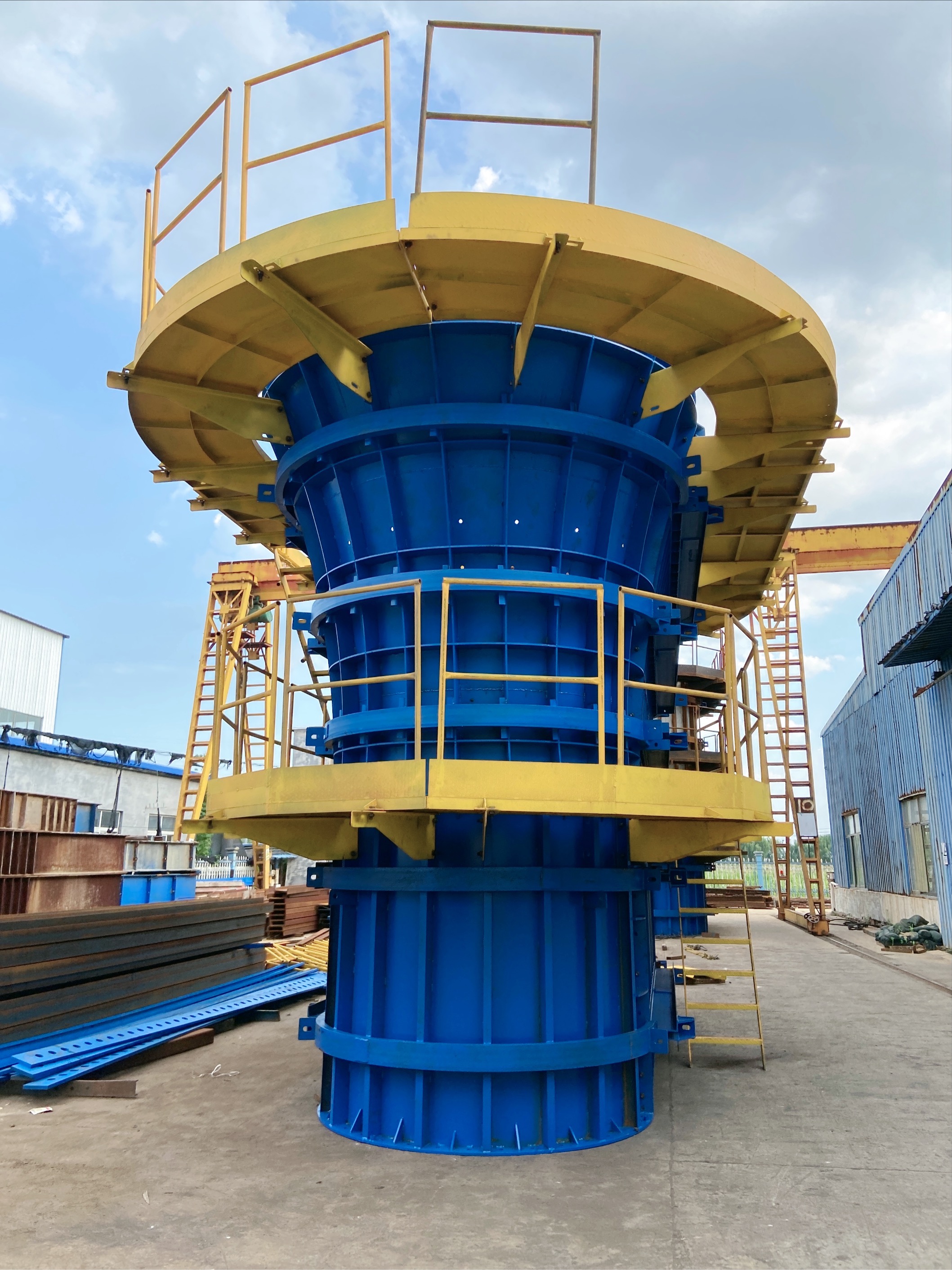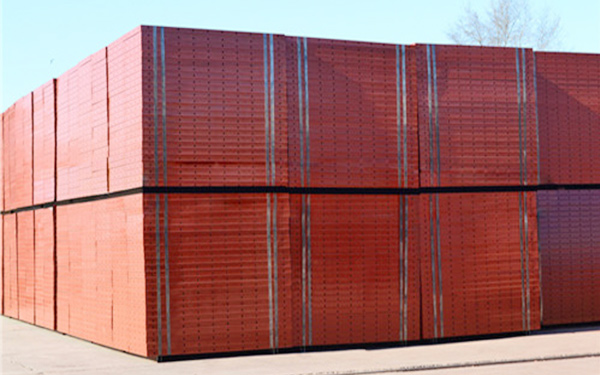Current position:
Home
News home
Industry News
Supplier of steel formwork rental station: How to deal with and prevent leakage of slurry in steel formwork?
Supplier of steel formwork rental station: How to deal with and prevent leakage of slurry in steel formwork?
source:Shandong Tianhong Heavy Industry Co., Ltd
Abstract:
Leakage of grout in steel formwork is a common quality problem in concrete construction, which can lead to defects such as honeycombing, pockmarks, and sand lines on the surface of the concrete. In severe cases, it can even affect the structural strength and durability. The following is a systematic prevention and treatment plan, covering the entire process of design, construction, and maintenance:
1、 Analysis of common causes of slurry leakage
Template's own defects
Excessive gap between seams (>2mm) or misalignment;
Deformation of template ribs and wear of bolt holes;
Panel corrosion, perforation or welding cracks.
Construction process issues
The sealing material (rubber strip, sponge strip) falls off or is not compacted;
The U-shaped card or bolt is not tightened or the spacing is too large;
The inclined installation of the template causes misalignment of the joints.
extrinsic factors
Excessive concrete slump (>180mm) and high lateral pressure;
Excessive vibration or collision of the vibrating rod with the template.
2、 Preventive measures: Stop plugging from the source
1. Template design and processing control
Optimize seam design:
Adopting "enterprise seam" or "double-sided tape+rubber strip" composite sealing (Figure 1) to reduce the risk of grout leakage in straight seams.
Schematic diagram of steel formwork joint design
Strict processing acceptance:
When the new template enters the site, check the flatness of the joints (using a 2m ruler to detect, with a gap of ≤ 1mm), and eliminate deformed and corroded templates.
2. Refined management of the construction process
Selection and installation of sealing materials:
Key Construction Points for Applicable Scenarios of Material Types
The thickness of double-sided foam adhesive strip plane joint and internal corner adhesive strip is 3~5mm, and 1~2mm is exposed after pasting
Rubber waterstop underground engineering, pre embedded with 10mm concrete on the side wall of the water tank, clamped and fixed with formwork
Silicone sealant with irregular joints and repaired holes should be scraped flat after injection, and should not be touched before curing
Fastener standard installation:
U-shaped card spacing ≤ 300mm, arranged alternately;
Add a rubber water stop ring to the tension bolt (for waterproofing projects), and tighten it to a maximum of 2 external threads;
Use specialized angle steel fixtures at corners to prevent "opening mouth" leakage of grout.
Concrete pouring control:
Layered pouring (each layer ≤ 500mm) to reduce lateral pressure impact;
The distance between the vibrating rod and the template should be ≥ 150mm to avoid direct contact with the template.
3. Targeted protection for special areas
Wall root:
The outer side of the formwork is blocked with cement mortar, and the inner side is provided with 20mm thick foam board to prevent "rotten roots".
Reserved holes:
Customized steel casing is used, and the welding joint between the casing and the template is fully coated with sealant.
Construction joint:
Install a quick closing mesh and add a grout stop plate on the outside.
3、 On site grading treatment of leakage slurry
1. Leakage of grout was found before pouring
Small gap (≤ 3mm):
Fill with double-sided tape or sponge strip, and reinforce with transparent tape on the outside.
Large gap (>3mm):
Add welding thin steel strip for plugging, or drill and drive wood wedge+glue injection.
2. Leakage of grout during pouring process
Slight leakage:
Quickly absorb the slurry with dry cement powder or sealing agent, pause pouring and reinforce the leakage point.
Jet leakage:
Immediately stop pouring, clean up the leaking areas, and temporarily seal them with steel plates and bolts (Figure 2).
Temporary Blockage Diagram
3. Quality repair after demoulding
Surface sand lines/rough surfaces:
Smooth with polymer cement mortar, and when there is a large color difference, apply a protective agent to the overall clear water concrete.
Hole/exposed reinforcement:
Chisel loose concrete → Remove rust → Apply interface agent → Fill with grouting material above C45.
Structural reinforcement:
When the leakage of grout causes a cross-sectional loss of more than 5%, it is necessary to stick carbon fiber cloth or wrap it with steel for reinforcement.
4、 Typical Case Handling Plan
Solution for addressing the causes of slurry leakage in the scene
The joint adhesive strip of the horizontal joint template of the bridge pier column is aging, and the leaking concrete is chiseled away. The formwork is re supported and the adhesive strip is thickened for pouring
The root of the basement wall is not tightly sealed, resulting in rotten roots and removal of loose parts. The inclined formwork is used to pour high strength grade fine stone concrete
The reserved opening sleeve of the floor slab is not tightly welded to the formwork, and reinforcement is drilled around the opening. The compensation section is poured again
5、 Long term maintenance and management
Template maintenance:
After each demoulding, clean the residual slurry, repair the deformed parts, and apply release agent;
Polish the corroded template with sandpaper and spray it with epoxy zinc rich primer.
Intelligent monitoring:
Using infrared thermal imaging to detect the sealing of template joints;
Install pressure sensors in the high support mold area to alert the side pressure to exceed the limit.
Personnel training:
Regularly organize special training on "Steel Template Leak proof Slurry" to strengthen practical skills such as sealing material installation and bolt tightening.
summarize
The control of steel formwork leakage should adhere to the principles of "design optimization, strict material selection, fine construction, and timely maintenance":
Prevention: Eliminate potential leakage hazards through enterprise seam design, multi-layer sealing, and standardized installation;
Handling: Quickly respond according to the degree of leakage and prioritize ensuring structural safety;
Upgrade: Combining new technologies such as BIM simulation of pouring pressure and intelligent monitoring to achieve the goal of zero slurry leakage.
Template's own defects
Excessive gap between seams (>2mm) or misalignment;
Deformation of template ribs and wear of bolt holes;
Panel corrosion, perforation or welding cracks.
Construction process issues
The sealing material (rubber strip, sponge strip) falls off or is not compacted;
The U-shaped card or bolt is not tightened or the spacing is too large;
The inclined installation of the template causes misalignment of the joints.
extrinsic factors
Excessive concrete slump (>180mm) and high lateral pressure;
Excessive vibration or collision of the vibrating rod with the template.
2、 Preventive measures: Stop plugging from the source
1. Template design and processing control
Optimize seam design:
Adopting "enterprise seam" or "double-sided tape+rubber strip" composite sealing (Figure 1) to reduce the risk of grout leakage in straight seams.
Schematic diagram of steel formwork joint design
Strict processing acceptance:
When the new template enters the site, check the flatness of the joints (using a 2m ruler to detect, with a gap of ≤ 1mm), and eliminate deformed and corroded templates.
2. Refined management of the construction process
Selection and installation of sealing materials:
Key Construction Points for Applicable Scenarios of Material Types
The thickness of double-sided foam adhesive strip plane joint and internal corner adhesive strip is 3~5mm, and 1~2mm is exposed after pasting
Rubber waterstop underground engineering, pre embedded with 10mm concrete on the side wall of the water tank, clamped and fixed with formwork
Silicone sealant with irregular joints and repaired holes should be scraped flat after injection, and should not be touched before curing
Fastener standard installation:
U-shaped card spacing ≤ 300mm, arranged alternately;
Add a rubber water stop ring to the tension bolt (for waterproofing projects), and tighten it to a maximum of 2 external threads;
Use specialized angle steel fixtures at corners to prevent "opening mouth" leakage of grout.
Concrete pouring control:
Layered pouring (each layer ≤ 500mm) to reduce lateral pressure impact;
The distance between the vibrating rod and the template should be ≥ 150mm to avoid direct contact with the template.
3. Targeted protection for special areas
Wall root:
The outer side of the formwork is blocked with cement mortar, and the inner side is provided with 20mm thick foam board to prevent "rotten roots".
Reserved holes:
Customized steel casing is used, and the welding joint between the casing and the template is fully coated with sealant.
Construction joint:
Install a quick closing mesh and add a grout stop plate on the outside.
3、 On site grading treatment of leakage slurry
1. Leakage of grout was found before pouring
Small gap (≤ 3mm):
Fill with double-sided tape or sponge strip, and reinforce with transparent tape on the outside.
Large gap (>3mm):
Add welding thin steel strip for plugging, or drill and drive wood wedge+glue injection.
2. Leakage of grout during pouring process
Slight leakage:
Quickly absorb the slurry with dry cement powder or sealing agent, pause pouring and reinforce the leakage point.
Jet leakage:
Immediately stop pouring, clean up the leaking areas, and temporarily seal them with steel plates and bolts (Figure 2).
Temporary Blockage Diagram
3. Quality repair after demoulding
Surface sand lines/rough surfaces:
Smooth with polymer cement mortar, and when there is a large color difference, apply a protective agent to the overall clear water concrete.
Hole/exposed reinforcement:
Chisel loose concrete → Remove rust → Apply interface agent → Fill with grouting material above C45.
Structural reinforcement:
When the leakage of grout causes a cross-sectional loss of more than 5%, it is necessary to stick carbon fiber cloth or wrap it with steel for reinforcement.
4、 Typical Case Handling Plan
Solution for addressing the causes of slurry leakage in the scene
The joint adhesive strip of the horizontal joint template of the bridge pier column is aging, and the leaking concrete is chiseled away. The formwork is re supported and the adhesive strip is thickened for pouring
The root of the basement wall is not tightly sealed, resulting in rotten roots and removal of loose parts. The inclined formwork is used to pour high strength grade fine stone concrete
The reserved opening sleeve of the floor slab is not tightly welded to the formwork, and reinforcement is drilled around the opening. The compensation section is poured again
5、 Long term maintenance and management
Template maintenance:
After each demoulding, clean the residual slurry, repair the deformed parts, and apply release agent;
Polish the corroded template with sandpaper and spray it with epoxy zinc rich primer.
Intelligent monitoring:
Using infrared thermal imaging to detect the sealing of template joints;
Install pressure sensors in the high support mold area to alert the side pressure to exceed the limit.
Personnel training:
Regularly organize special training on "Steel Template Leak proof Slurry" to strengthen practical skills such as sealing material installation and bolt tightening.
summarize
The control of steel formwork leakage should adhere to the principles of "design optimization, strict material selection, fine construction, and timely maintenance":
Prevention: Eliminate potential leakage hazards through enterprise seam design, multi-layer sealing, and standardized installation;
Handling: Quickly respond according to the degree of leakage and prioritize ensuring structural safety;
Upgrade: Combining new technologies such as BIM simulation of pouring pressure and intelligent monitoring to achieve the goal of zero slurry leakage.
Disclaimer: The content provided on this website is for reference only (some information is sourced from the internet). The publication of content information is for the purpose of transmission and does not represent the views of this website. If the content involves copyright issues, please contact the website editor in a timely manner, and we will take appropriate measures to avoid unnecessary losses for both parties.
Related article
- Customized specifications for steel formwork: What factors need to be considered in calculating the weight of steel formwork?
- Rental price of steel formwork: Analysis of key points for concrete construction of bridge special-shaped column formwork
- Composite steel formwork manufacturer: What are the advantages and disadvantages of steel formwork compared to wooden formwork and aluminum formwork?
- Manufacturer of standardized steel formwork: How much impact does leakage of formwork joints have on structural safety?
- Bridge anti-collision guardrail steel formwork: What are the common methods for correcting steel formwork?
- How to calculate the bearing capacity of steel formwork for rental manufacturers of construction steel formwork?
- Steel formwork manufacturer: How long is the lifespan of stainless steel formwork?
- Pulling out Mountains and Rivers for Win Win - Jining Tianli Employees Celebrate National Day Holiday with Tug of War Competition
- Customized rental of construction steel formwork: How to ensure the installation accuracy of steel formwork?
- Customized manufacturer of composite steel formwork: How to prevent and deal with steel formwork that is not allowed to be reserved or embedded?
- Template manufacturer: What are the specific risks of grout leakage to construction safety?
- Customized rental of steel formwork: What are the dimensions, specifications, and models of steel formwork?
Hot article

- T梁模版
- Pulling out Mountains and Rivers for Win Win - Jining Tianli Employees Celebrate National Day Holiday with Tug of War Competition
- 力“拔”山兮,“河”作共赢——济宁天力员工欢度国庆假期之拔河比赛
- Pulling out Mountains and Rivers for Win Win - Jining Tianli Employees Celebrate National Day Holiday with Tug of War Competition
- Pulling out Mountains and Rivers for Win Win - Jining Tianli Employees Celebrate National Day Holiday with Tug of War Competition
- Pulling out Mountains and Rivers for Win Win - Jining Tianli Employees Celebrate National Day Holiday with Tug of War Competition
- Pulling out Mountains and Rivers for Win Win - Jining Tianli Employees Celebrate National Day Holiday with Tug of War Competition
Recommended article

Customized rental of construction steel formwork: How to prevent and deal with loose joints in steel formwork?

Customized rental of steel formwork: What are the dimensions, specifications, and models of steel formwork?
- Customized rental of construction steel formwork: How to prevent and deal with loose joints in steel formwork?
- Customized rental of steel formwork: What are the dimensions, specifications, and models of steel formwork?
- Steel formwork manufacturer supply specifications: What are the applicable fields for steel formwork
- 力“拔”山兮,“河”作共赢——济宁天力员工欢度国庆假期之拔河比赛
- Pulling out Mountains and Rivers for Win Win - Jining Tianli Employees Celebrate National Day Holiday with Tug of War Competition
- Pulling out Mountains and Rivers for Win Win - Jining Tianli Employees Celebrate National Day Holiday with Tug of War Competition
- Pulling out Mountains and Rivers for Win Win - Jining Tianli Employees Celebrate National Day Holiday with Tug of War Competition
- Pulling out Mountains and Rivers for Win Win - Jining Tianli Employees Celebrate National Day Holiday with Tug of War Competition



